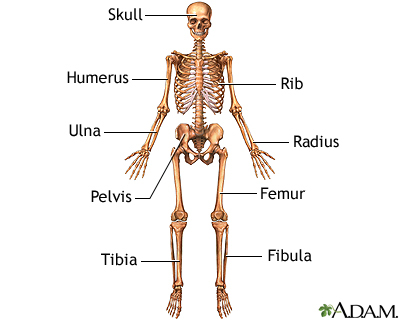Blount disease
Definition
Blount disease is a growth disorder of the shin bone (tibia) in which the lower leg turns inward, making it look like a bowleg.
Alternative Names
Blount's disease; Tibia vara
Causes
Blount disease occurs in young children and adolescents. The cause is unknown. It is thought to be due to the effects of weight on the growth plate. The inner part of the shin bone, just below the knee, fails to develop normally.
Unlike bowlegs, which tend to straighten as the child develops, Blount disease slowly gets worse. It can cause severe bowing of one or both legs.
This condition is more common among African American children. It is also associated with obesity and early walking.
Symptoms
One or both of the lower legs turn inward. This is called "bowing." It may:
- Look the same on both legs
- Occur just below the knee
- Rapidly get worse
Exams and Tests
The health care provider will examine you. This will show that the lower legs turn inward. An x-ray of the knee and the lower leg confirms the diagnosis.
Treatment
Braces are used to treat children who develop severe bowing before the age of 3.
Surgery is most often needed if braces do not work, or if the problem is not diagnosed until the child is older. Surgery may involve cutting the shin bone to place it in the proper position. Sometimes, the bone will be lengthened as well.
Other times, surgery is done to restrict the growth of the outer half of the shin bone. This allows the child's natural growth to reverse the bowing process. This is a much smaller surgery. It works best in children with less severe symptoms who still have quite a bit of growing to do.
Outlook (Prognosis)
If the leg can be placed into the proper position, the outlook is good. The leg should work properly and look normal.
Possible Complications
Failure to treat Blount disease may lead to progressive deformity. The condition may lead to differences in leg lengths, which can result in disability if not treated.
Blount disease may come back after surgery, especially in younger children.
When to Contact a Medical Professional
Call your child's provider if your child's leg or legs appear to be bowing. Also call if your child has bowed legs that appear to be getting worse.
Prevention
Weight loss for overweight children may be helpful.
Gallery

References
Sheffer BW. Osteochondrosis or ephiphysitis and other miscellaneous affections. In: Azar FM, Beaty JH, eds. Campbell's Operative Orthopaedics. 14th ed. Philadelphia, PA: Elsevier; 2021:chap 32.
Winell JJ, Baldwin KD, Wells L. Torsional and angular deformities of the limb. In: Kliegman RM, St. Geme JW, Blum NJ, Shah SS, Tasker RC, Wilson KM, eds. Nelson Textbook of Pediatrics. 21st ed. Philadelphia, PA: Elsevier; 2020:chap 695.